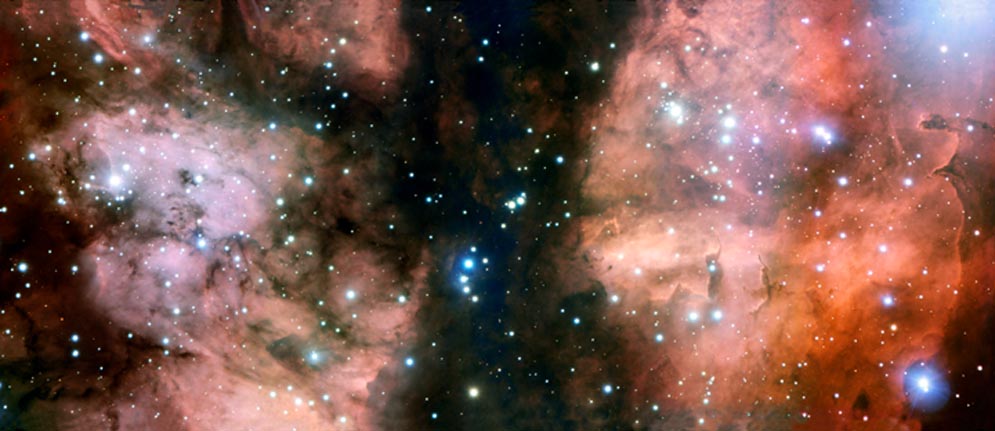
Description: Star Formation Nebula
Position (J2000): RA 17hr 26m 28.86s Dec -34° 12' 0.26"
Constellation: Scorpius
Distance: 8000 light years
Field of view: 15.80 x 6.57 arcminutes
Orientation: North is 55.4° left of vertical
Image Credit: ESO
Release date: June 20, 2012
Related images: N1309 S1015 S0654 N1226 N1612
ABOUT THIS IMAGE:
ESO's Very Large Telescope (VLT) has taken the most detailed image so far of a spectacular part of the stellar nursery called NGC 6357. The view shows many hot young stars, glowing clouds of gas and weird dust formations sculpted by ultraviolet radiation and stellar winds.
Deep in the Milky Way in the constellation of Scorpius (The Scorpion) lies NGC 6357 [1], a region of space where new stars are being born in of chaotic clouds of gas and dust [2]. The outer parts of this vast nebula have now been imaged by ESO's Very Large Telescope, producing the best picture of this region taken so far [3].
The new picture shows a broad river of dust across the center that absorbs the light from more distant objects. To the right there is a small cluster of brilliant blue-white young stars that have formed from the gas. These are probably only a few million years old, very young by stellar standards. The intense ultraviolet radiation streaming out from these stars is hollowing out a cavity in the surrounding gas and dust and sculpting it in strange ways.
The whole image is covered with dark trails of cosmic dust, but some of the most fascinating dark features appear at the lower right and on the right hand edge of the picture. Here the radiation from the bright young stars has created curious elephant trunk columns, similar to the famous "pillars of creation" in the Eagle Nebula (n9544). Cosmic dust is much finer than the more familiar domestic variety. It more closely resembles smoke and consists mostly of tiny particles of silicates, graphite, and water ice that were produced and expelled into space by earlier generations of stars.
The bright central part of NGC 6357 contains a cluster of high-mass stars whose inhabitants are among the brightest in our galaxy. This inner region, not seen in this new picture, has been much studied and imaged by the NASA/ESA Hubble Space Telescope (s0654b). But this new picture shows that even the less well known outer parts of this nursery contain fascinating structures that can be revealed by the power of the VLT.
Notes:
[1] This object also bears the curious name War and Peace Nebula, which has no link to Tolstoy's great novel, but was given to this object by scientists working on the Midcourse Space Experiment. They noted that the bright, western part of the nebula resembled a dove, while the eastern part looked like a skull in their infrared images. Unfortunately this effect cannot be seen in the visible-light image presented here. The object is also occasionally nicknamed the Lobster Nebula.
[2] NGC 6357 was first recorded visually by John Herschel from South Africa in 1837. He only recorded the brightest central parts and the full scale of this huge nebula was only seen in photographs much later.
[3]
The part of NGC 6357 shown in the new VLT image has not been targeted
by the NASA/ESA Hubble Space Telescope.